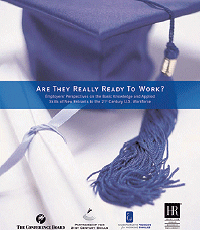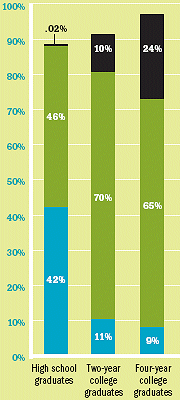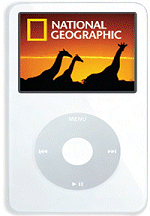Technology + Online + Industry + Partnerships
Employers Say US Grads Don’t Have What It Takes
A report reveals concerns over the newest generation of workers’ fitness for the global economy.

POOR REPORT CARD Employers
give new entrants into the US workforce
a slew of subpar grades.
IF JOHNNY CAN’T read, write, or do basic math, then he doesn’t stand much of a chance once he enters the workforce, which is precisely what a new report from a collaboration of business research organizations indicates. The report finds that the current pool of graduates from US high schools, vocational schools, and two- and four-year colleges lacks the necessary academic and more-advanced applied skills (such as professionalism and work ethic) for success in the world economy.
The result of a collaboration among The Conference Board, Corporate Voices for Working Families, the Partnership for 21st Century Skills, and the Society for Human Resource Management, the report is titled “Are They Really Ready to Work? Employers’ Perspectives on the Basic Knowledge and Applied Skills of New Entrants to the 21st Century US Workforce.” It draws from a survey of 431 human resources officials and other senior executives conducted during April and May of this year.
The good news: The majority of respondents answered that high school graduates are sufficiently prepared for the workforce in the areas of technology, teamwork, and diversity. “All three are areas where business leaders, educators, and communities have focused uni- fied energy and resources in recent years,” says Donna Klein, president and CEO of Corporate Voices for Working Families. “These results suggest that when a particular skill is viewed uniformly as critical and is targeted, success and progress are possible.” However, the findings mainly reflect employers’ frustration over the lack of development young people demonstrate in more basic areas. Almost 70 percent of respondents said that high school graduates lack personal accountability and effective work habits— including the ability to manage time and workload. A majority of the surveyed employers also said that recent graduates lack basic reading comprehension, writing, and problem-solving skills.
“It is clear from the report that greater communication and collaboration between the business sector and educators is critical to ensure that young people are prepared to enter the workplace of the 21st century,” says Richard Cavanagh, former president and CEO of The Conference Board. He adds that an influx of underprepared graduates into the American workforce will affect the country’s ability to compete in the global economy.
Eighty-one percent of those surveyed said high school grads lack good written communication skills. Many (47 percent and 28 percent, respectively) found the same deficiency in two- and four-year college graduates.
Download the full report here.
 A STATE OF UNREADINESS
A STATE OF UNREADINESS
High school graduates entering the workforce are widely seen as insufficiently prepared. College grads rate better, but are considered only adequate. Level of “overall preparation” for the workforce, according to surveyed employers:
- Deficient (blue)
- Adequate (green)
- Excellent (black)
*Percentages do not add up to 100 because not all companies hire from all categories.
Source: “Are They Really Ready to Work?” (2006);www.conference-board.org.
:: Awards and Contests
GOOD NEWS FOR SCHOOLS IN NEED OF HIGH-RESOLUTION PROJECTION CAPABILITY. T.H.E. Journal magazine will be following the K-12 classroom use of three Canon REALiS X600 multimedia projectors— affordable equipment that boasts razorsharp projection ideal for the study of detailed material—to see how advances in “smart classroom” technology (such as Canon’s brand-new “AISYS Enhanced” LCOS technology) are actually impacting classroom work. Results of the study will be covered in the magazine and on our website. The editors of this publication will select three (3) schools to be the lucky recipients of the projectors; the projectors will become the property of the schools. We are looking for classrooms with high-resolution projection requirements or the need for high levels of clarity. Interested parties should submit a brief explanation (100 words or less) of study environment and need, emphasizing compelling study challenges and innovative use of theprojection technology.
Special consideration will be given to programs with budget constraints. E-mail entries to: [email protected], by December 30, 2006.
:: Industry News
GLENCOE/MCGRAW-HILL, HOTCHALK OFFER FREE PD COURSES. Glencoe/McGraw-Hill, the Columbus, OH-based provider of educational solutions for secondary schools, has partnered with HotChalk, a web 2.0 community software application for connecting teachers, students, and parents. Through this new alliance, Glencoe/McGraw-Hill will offer its professional development courses to all secondary school teachers who are members of the HotChalk community, including one free professional development course of each teacher’s choice. The online, video-based courses cover a range of subjects and teaching strategies for grades 6-12.
Teachers can log on to HotChalk at any time to access the course offerings, which include continuing-education credits. After the free trial course is completed, additional courses may be purchased. For more information, click here.
NEW GRANT FUNDS ACADEMIC PERFORMANCE STUDY. The Lexington, MA-based Research Institute for Learning and Development (ResearchILD) has received a grant to fund a new, yearlong pilot and research study to measure the efficacy of two of its software applications designed to help improve academic performance. The Cisco Systems Foundation cash grant of $78,000, courtesy of the Cisco Systems New England Civic Council, will fund the entire study being conducted at Douglas Elementary School in Acton, MA, which will span the full 2006-2007 school year.
The two software programs the study will look at are BrainCogs and Essay- Express, co-produced by ResearchILD and FableVision, an educational media technology developer and publisher. The study will also include a new peer-mentoring program, as well as ongoing professional development and support for educators at Douglas Elementary School.
The project is part of a bigger initiative called “Drive to Thrive: Fostering Persistence, Effort, and Resilience,” which is designed to identify predictors of life success in students, especially those whohave learning and attention difficulties.
PROMETHEAN PARTNERS WITH EXPLORE LEARNING FOR MATH AND SCIENCE LESSONS. Promethean, a provider of interactive learning technology, has teamed with ExploreLearning to allow users of Promethean’s Activclassroom to utilize ExploreLearning’s catalog of modular, interactive simulations in math and science for students in grades 6-12. Activclassroom enables teachers to deliver animated and sound-enabled content in their classrooms.
ExploreLearning’s simulations, called Gizmos, are supplemental curriculum materials that use scientific research to show that the use of computer-based manipulatives impacts student achievement. Gizmos are correlated to state and national standards and to most leading textbooks.
NEON RELEASES NEW VERSION OF CYBERGAUGE. Neon Software, a network management software company, has introduced CyberGauge 7.0 for Windows. Cyber- Gauge helps network administrators monitor and manage their internet bandwidth by automatically creating real-time utilization graphs, in addition to daily, weekly, and monthly quality-of-service and billing reports. The software works with any SNMP-based device, including routers, switches, and servers.
The new release creates custom-sized JPEG chart exports and allows easy viewing, printing, exporting, or saving for long-term trend analysis and bandwidth planning. Network administrators may also configure CyberGauge to copy a chart image to an FTP site so that a JPEG can be included on any web page for use as a real-time traffic monitor, or as a way to view a bandwidth test remotely. Cyber- Gauge is priced based on the number of devices monitored. Prices start at $395 for five devices with any number of interfaces; upgrades start at $99.
 One Tablet for All at De La Salle This fall, every member of the freshman class at Chicago’s De La Salle Institute will be equipped with a tablet PC, thanks to an assist from CDW-G, a provider of information technology solutions to educators, which helped the school find the best products and pricing for its program. The tablet program at the private Catholic high school has been five years in the making, and the new PCs will be preloaded with software and textbooks on several subjects, including algebra.
One Tablet for All at De La Salle This fall, every member of the freshman class at Chicago’s De La Salle Institute will be equipped with a tablet PC, thanks to an assist from CDW-G, a provider of information technology solutions to educators, which helped the school find the best products and pricing for its program. The tablet program at the private Catholic high school has been five years in the making, and the new PCs will be preloaded with software and textbooks on several subjects, including algebra.
De La Salle’s goal is to increase student achievement and better prepare kids for college through the use of tablet PCs and wireless LCD projectors. To that end, the PCs, projectors, and other wireless-enabled technologies will be used in every classroom, allowing teachers to move away from the front of the classroom and interact more with the students.
Prior to launching the 1-to-1 program, school administrators assessed their needs and developed a technology plan that included professional development and instructional technology strategies. De La Salle also consulted other schools that had established tablet PC or laptop programs in order to better understand best practices in curriculum development, teaching strategies, classroom management, and technology infrastructure.
:: District-Vendor Partnerships
VIEWPOINT SCHOOL GETS NEW WIFI NETWORK. Xirrus, a provider of high-capacity, long-range WiFi products that extend wired network capabilities to wireless, has deployed support for the new campuswide wireless network at Viewpoint School, a K-12 college preparatory school in Calabasas, CA. The network connects more than 1,200 students and faculty across the 25-acre campus. Viewpoint now has the ability to deliver any application requiring voice, video, or data to wireless notebooks, security cameras, and eventbroadcasting.
The deployment utilized a wide range of Xirrus equipment, including 12 Arrays (two XS-3900s, nine XS- 3700s, and one XS-3500), one XM-3300 Management Platform, and two XS-3100 Remote Power Systems. Each WiFi Array is able to support three classrooms.
:: Online Learning
QUESTIA SURVEY REVEALS TEACHERS’ MISTRUST IN WEB SOURCES. Questia, an online educational research resource, has released the results of its nationwide online survey of secondary school educators. The report reveals the anxiety teachers feel over the presence of unreliable information on the web, and their students’ susceptibility to it. They doubt kids’ ability to discern good information from bad.
The great majority (95 percent) of respondents encourage their students to use the web for research, but they have difficulty directing kids to web content that is current, reliable, and safe. Nearly eight in 10 teachers are concerned about their students’ use of inaccurate information. Additionally, more than half said student cheating and plagiarism—an outgrowth of doing online research—alsoconcerns them.
 DOWNLOAD PODCASTS FOR FREE. The National Geographic Society and National Geographic magazine are offering free downloadable audio and video files. Students and teachers can experience an African safari, catch the week’s top science and nature news stories, and listen to interviews and songs from music stars around the world.
DOWNLOAD PODCASTS FOR FREE. The National Geographic Society and National Geographic magazine are offering free downloadable audio and video files. Students and teachers can experience an African safari, catch the week’s top science and nature news stories, and listen to interviews and songs from music stars around the world.
The podcasts are also available through Apple’s iTunes and Yahoo!. The free offerings include “National Geographic News,” “Afropop Worldwide,” and Traveler Magazine’s “50 Walks of a Lifetime.” Each podcast is focused on specific geographic or cultural areas National Geographic has covered in its 118 years of publication.
Connect and Join With Those Far Away A new online portal brings separated families together. Connect and Join, a family support and education services publishing company, has created a new, secure online communications portal designed to keep family members connected whenever professional circumstances or commitments— such as military deployment or business trips—cause them to be separated. The subscription-based website community allows users to interact privately with one another.The site also meets federal Operational Security Guidelines.
Connect and Join’s site was designed to foster project-based learning, that is, learning by doing; studies indicate that PBL helps students with lesson retention. Users can hone their technology skills by messaging and calendaring, online scrapbooking, and event archiving, as well as completing computer-based arts and crafts projects.
Using materials provided on the Connect and Join site, families can build their own web pages. Each registration allows five users, with a family editor to oversee all content, including photos and other scanned images. Connect and Join’s version 2 release will contain an area for children to keep a “Days While You Were Away” journal, as well as an option to share books they are reading and artwork with the parent who is away. The portal also has a section for teens.